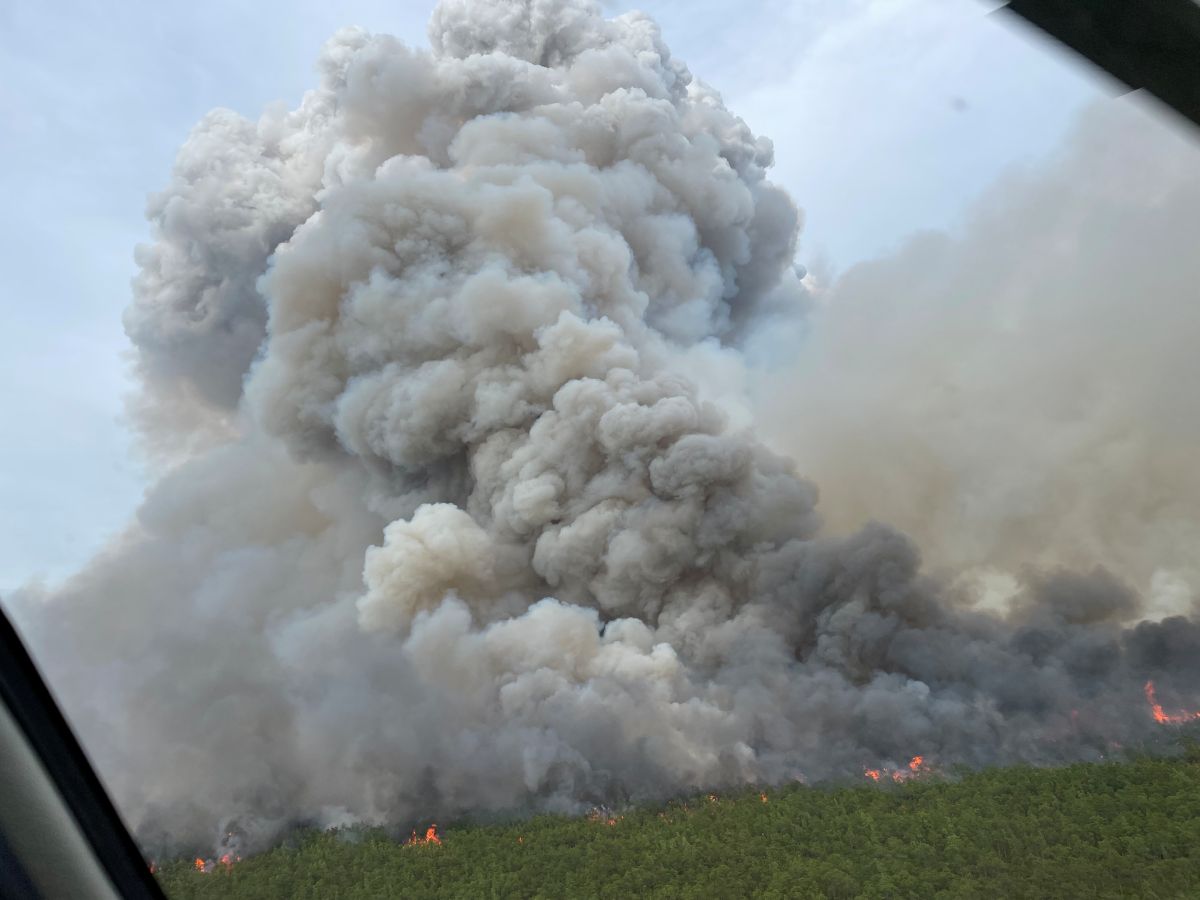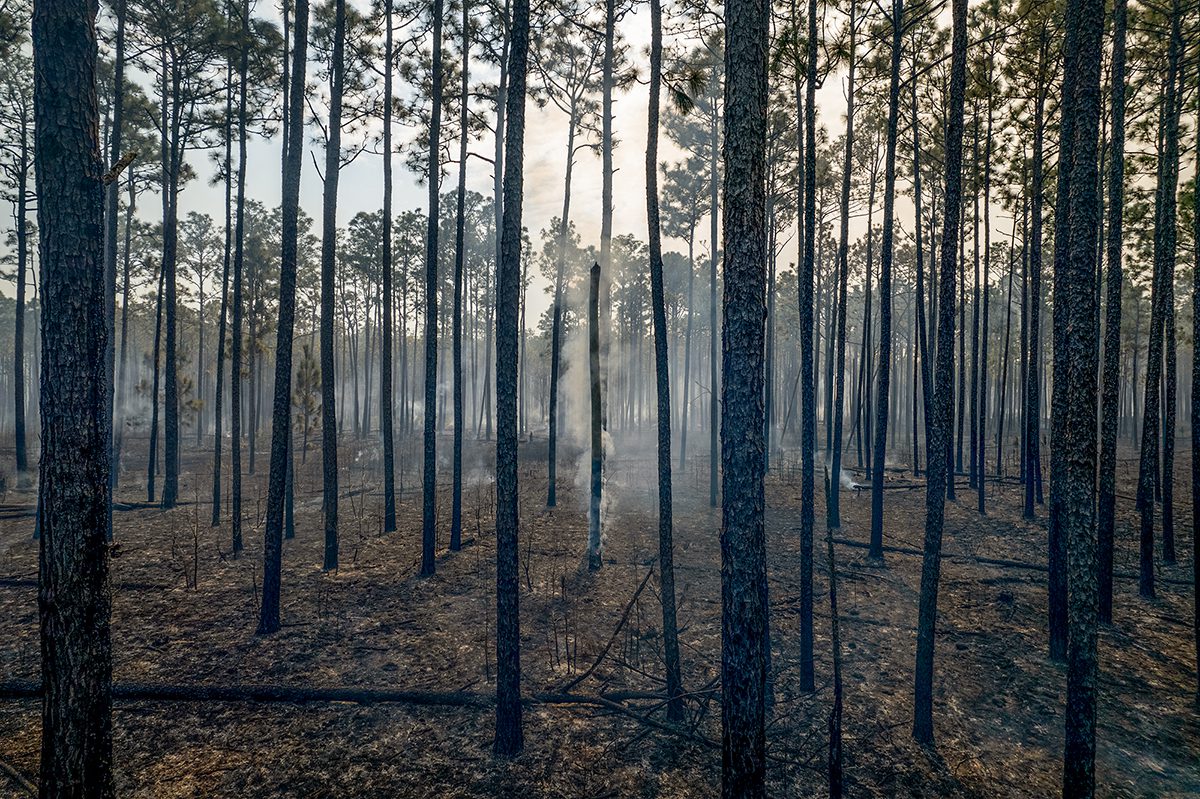
Second part in a series.
While wildfires are almost always the result of human activity, climate change is altering wildfires and how they’re managed.
Supporter Spotlight
North Carolina Forest Service Public Information Officer Philip Jackson said that while nearly all wildfires in the state correlate with human activity, climate change is affecting the nature of wildfires different ways.
First, the way precipitation falls is changing and becoming more extreme, Assistant State Climatologist Corey Davis said in an interview. “Instead of rain evenly spread out throughout a season or year, heavier rainfall is happening on fewer days with longer dry spells in between.”
Warming temperatures are an important part, too, and are making dry spells more severe and prone to wildfire activity. This has been especially apparent within the past few years. Last fall and again in June of this year, the state slipped into drought after just a few weeks of hot, dry weather.
“At both times, parts of the state went more than 20 days in a row without a drop of rainfall all while we were dealing with unseasonably warm temperatures — above 100 degrees in some areas earlier this summer,” Davis said. “Just like in your backyard garden, forests and other fire-prone ecosystems dry out in a hurry during times like that, and that brings the threat of wildfires.”
The State Climate Office, based in Raleigh, uses a handful of tools to monitor climate change and its effects, including measuring and archiving weather observations from more than 350 weather stations across the state, almost half of which have at least 30 years of historical observations.
Supporter Spotlight
Davis said this helps with understanding not only what current conditions are like, but also how conditions are changing, “and we’re consistently seeing more extremes in all directions.”
Most recently, that has been record rainfall totals in from Hurricane Helene in western North Carolina. Earlier this summer, conditions were extreme heat and dry weather. Davis’ office can use that kind of historical data to add context to those events. He cited Greenville as an example: The Pitt County city saw its longest streak of dry weather — 23 consecutive days without rainfall — since the fall of 2000.
The office is involved with research and partnerships that are helping explore climate change and its impacts, as well.
“Heat-mapping campaigns have shown us how much hotter certain parts of cities can get depending on their land use and land cover. There are applications there for forests, too, since we’ve found at a very micro scale on NC State’s campus, for instance, how bare ground and a lack of tree cover can affect surface temperatures,” he said.
That data, research and those partnerships all came together in the North Carolina Climate Science Report that the state climate office helped compile in 2020.
The report includes some key findings and projections related to wildfires, including a projected 300% or more increase in the number of weeks with the risk of very large fires, or burning more than 5,000 hectares – nearly 12,400 acres – by the middle of this century, compared to the end of the last century.
“And it notes that increases in temperatures and associated drying rates are very likely, with future droughts very likely to be warmer with a higher chance of wildfires,” Davis said.

Temperatures across the state are trending warmer in all four seasons, but it’s especially remarkable how much winters have been warming. According to the Climate Trends Plotter tool, the winter average temperatures in eastern North Carolina have been increasing by 0.5 to 0.75°F per decade over the past 50 years, and by more than 1.5 degrees Fahrenheit per decade in most areas since the year 2000.
“That’s having the effect of shrinking our winter seasons, and on the shoulders especially in February, we’re seeing more spring-like weather. That’s threatening to begin our spring fire seasons even earlier, and have them last even longer,” Davis said.
“We also see those changes reflected in future projections,” he continued, siting one study that projects a 74% increase in the area burned by lightning-caused wildfires in North Carolina between 2011 and 2060. “That’s a product of both longer fire seasons and warmer temperatures throughout the spring that make fuels more susceptible to burn.”
Other research shows more than a 200% increase in the number of days with suitable conditions for very large wildfires, which burn more than 12,000 acres, along the state’s coastline.
“Historically, these events have been very rare since they require all of those weather ingredients — extreme dryness in place with warm temperatures, low humidity, and high winds — for fires to grow that large in our region. But they’re expected to happen more often in the future,” Davis said.
Prescribed burns and climate change
Jackson explained that prescribed burns benefit forests and wildlife while reducing the risk and impacts of future catastrophic wildfires. The goal for these hazard reduction burns is to reduce the understory shrubs, vines, woody debris, needles and leaves that may be available to burn during unplanned wildfires.
“We will burn it in a planned manner that is of lower intensity, eliminating those fuel sources, helping prevent future wildfires or minimizing impacts from future wildfires. Low intensity prescribed fire also helps manage forestlands where many species require frequent burns to establish and thrive,” Jackson said.
The Forest Service also uses prescribed fire for site preparation purposes, also known as site-prep burns.

“These prescribed burns occur after harvesting to assist with reforestation activities. It allows for planting natural regeneration of tree seedlings, it’s less invasive and damaging than mechanical site preparation and is sometimes conducted as a pre-treatment to tree planting,” Jackson said.
Davis said that there’s been a lot of success with prescribed burns in North Carolina, and even though there’s still wildfires, those events are typically more manageable and less severe because of proactive prescribed burning practices, “But it’s already getting tougher to find windows to do this burning, and that problem is expected to become even worse in the future,” for a few reasons.
One, North Carolina is a fast-growing, fast-developing state, and we’ve got more acreage classified as wildland-urban interface than any state in the country, Davis explained.
“That means when we want to do burns in these natural areas, it’s more likely that people will notice it, so land and fire managers have to be very careful about burning when the wind direction is just right and making sure burns don’t linger overnight, when smoke can get trapped near the ground,” Davis said. “But climate change is also affecting our ability to burn. We’re getting fewer of those Goldilocks days when it’s not too wet or not too dry to have a successful burn, and the rapid changes from wet to dry patterns are making it tough to anticipate those periods.”
Historically, the most common times for burning in the spring and summer are becoming less suitable for burning as conditions then are hotter and drier, Davis said.
He explained that a study of the Southeastern United States looked at the suitability of prescribed burning based on projected weather conditions, and it found a sharp decrease in the number of suitable days in the transition seasons, or spring and fall, with the summer expected to become almost entirely unsuitable for burning by the end of the century.
“That’s largely driven by the warming temperatures, which makes the atmosphere less stable, the vertical transmission of heat and dispersion of smoke less predictable, and fuels drier so that they burn hotter and flames spread more quickly,” Davis said. “That’s all adding up to a big concern that we’ll see more frequent and more severe wildfires, with fewer opportunities to manage our forests in North Carolina to help avoid those events.”
Jackson said that the Forest Service predetermines weather and fuel parameters needed in order to safely execute a prescribed burn operation.
“If the weather doesn’t produce the ideal conditions that we need to safely carry out a burn, we simply won’t do it,” Jackson said, explaining that he has driven two hours to Stokes County, geared up in full personal protective equipment along with a dozen other personnel to conduct a prescribed burn, “only to cancel it before ever lighting a torch and putting fire on the ground. The weather either gives us what we need to carry out a burn safely, or it doesn’t. And if it doesn’t, we simply live to fight another day.”








